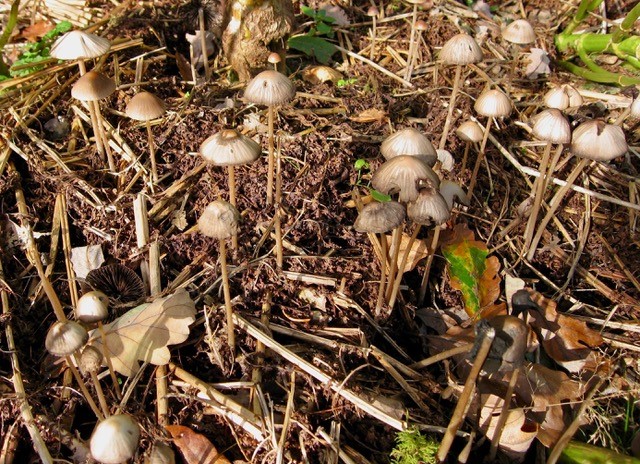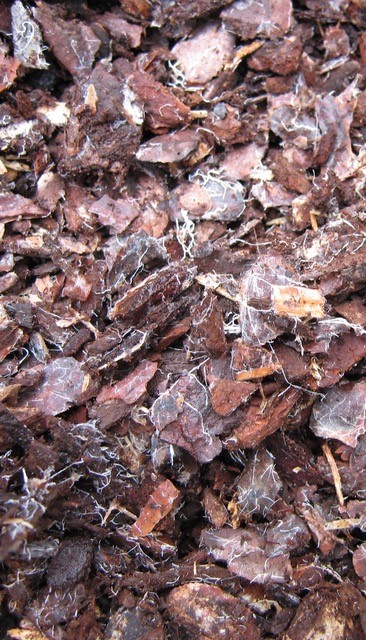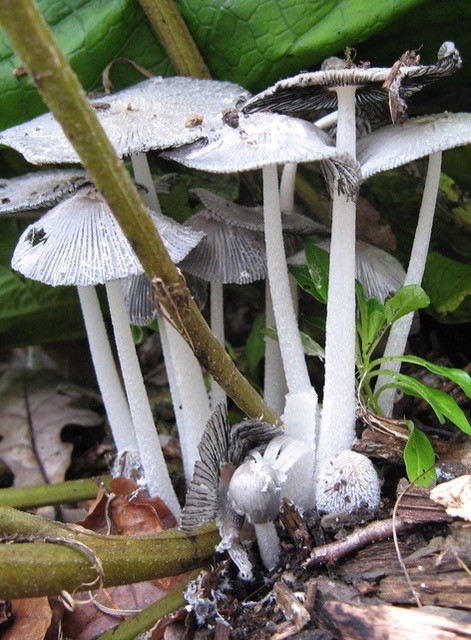Astonishing discoveries about the biological communications network beneath our feet suggest new ways we can wire our gardens into the web of life.
Almost a year ago to the day, I began liberating parts of my garden from what had become a black plastic mulch-covered tomb. I imagined, amidst the enthusiasm, that it was all about improving my garden’s soil. Twelve months on, there’s fresh evidence each day that I couldn’t have been more naive. ‘Improvement’ has been a big factor, but I’ve learnt in this last year that it’s about so much more.

When I stripped back the plastic sheet and piled on shredded twigs and branches, plus some leaf mould, during last November’s darkening days (find out why and how I did it here), I had no real idea that I would be aiding a bit of local biological rewiring of a life support system that quietly lives, pulses and – wait for it – communicates beneath our feet. As I’ve metaphorically dug deeper into understanding the transformation of my soil, the notion of ever actually digging it over again has become an irresistible, back-saving no-no.
I knew that the shredded material (aka chipped branch wood) would add nutrients to my previously unimproved soil, and that as it decayed it would boost myriad soil life, both obvious and unseen; increased earthworm activity has been unmissable when I’ve gently rummaged around in the top few inches of the soil. But it’s become clear that there’s much more going on. The woody chips started out green and sappy; after a month or so, those mixed into the soil surface had darkened and turned noticeably ‘mouldy’, while those lying dry on the surface showed little change. I’ve gleaned enough from a gardening lifetime to realise that the mouldy wood chips were being broken down by fungi carried in the leaf mould I used as an inoculant, as well as those already present in the soil. Up close, I could see that the pale coating of mycelium was not just encasing the chips, but that its single cell-thick hyphae were also growing under the bark and down between the cracks in the wood. They also had a divine ‘mushroomy’ smell. To my mind, it was just nature getting on with the job of rotting the woody chips down into soil-improving humus. But then came the toadstools.

A month or so later, and regularly ever since, the parts of my garden that I’ve set about improving have grown not just an impressive show of flowers and some edible crops, but flush after flush of toadstools. I’ve never suffered with mycophobia (a fear of mushrooms and other fungi), but I did a double-take when the first batch appeared, some right next to plant stems and emerging from between their roots. They have done zero harm. In fact, the plants (including weeds) that the toadstools have popped up next to have been amongst the healthiest I’ve ever grown. These fungi are clearly not killers like much-feared honey fungus, but collaborators; my plants have thrived with extraordinary vigour. Intrigued, I traced a toadstool stalk back to its underground origin, where it was attached to a pale web of mycelium linking the decaying woody chips with the surrounding soil. Autumn has seen new toadstools spring up daily, and they’re still coming thick and fast. As above-ground gardening life winds down for winter, there’s still a party going on underground.
And what a party it is. The pale mycelium that encases the wood chips is just the visible (and smellable) part of a soil-wide network of fungal mycelium that has spread throughout my liberated soil. The toadstools are merely the obvious tip of an interconnected underground iceberg; they are ephemeral structures designed to periodically disperse spores onto the breeze, allowing the fungus to spread and reproduce. As I’ve gradually dug deeper into what is happening in my soil, I find myself mulched ever deeper in awe and wonder. Two discoveries in particular, made via our overground, human-made internet, have rocked my mind.

The mycologist Paul Stamets (his TED presentation is a must-watch) has calculated that a single cubic inch of soil can contain around eight miles of mycelial cells (mycelium is composed of filamentous hyphae massed together). He also explains how fungi were the first organisms to inhabit the land 1.3 billion years ago, and how – because they don’t need sunlight to photosynthesise – they have inherited the earth following past impacts by meteorites that have plunged our biosphere into darkness, wiping out most other life. It was Stamets who coined the phrase ‘earth’s internet’ to describe the biological superhighway we’re just discovering beneath our feet.
An awesome example of how this living internet works comes from Suzanne Simard, professor of forest ecology at the University of British Columbia (her TED presentation is a must-must-watch). In a nutshell, she has shown how trees in a forest can actually communicate with each other. They talk. One example is how mature ‘mother trees’ can help young saplings – which they can recognise – to thrive by reducing their own root competition. She also found that in winter, evergreen conifers pass sustenance, via their roots, to leafless deciduous trees which are temporarily unable to make their own. Different tree species, despite what we’ve long assumed, are collaborative rather than competitive. Individual trees can also send signals to others, warning them of imminent pest attack, so they can raise their own defences. These biological signals and resources travel through the roots, but also through something else: the mycelial network in the soil into which the roots of trees and other plants are intimately wired. In a quid pro quo arrangement, fungi receive sustenance from the trees. Simard’s view is that an ‘old growth’, multi-species forest, connected by an underground network of what she calls ‘infinite biological pathways’, acts as a single organism. It’s humbling, mind-blowing stuff and you won’t fail to be enthralled the deeper you double-dig into it.
I can’t claim that my garden is acting as a single organism, but there is something extraordinary going on underground – as the toadstools testify. The use of mycorrhizal fungi – those which form intimate relations with plant roots – isn’t new to gardening. We use them in planting holes and sprinkled over rootballs, especially where ground is being replanted with the same type of plant (think roses). These manufactured products claim to impart multiple benefits, such as increased nutrient uptake and better drought resistance, although the jury remains divided on their effectiveness. All I did was simply shred some woody twigs and branches, add a dash of leaf mould, then mix them into the soil, with astounding results. Is there any reason you wouldn’t want to try this at home?

There’s virtually no information available on how nurturing earth’s internet can help us grow better, healthier gardens, and we sorely need some. We also need to hear heaps less about the antiquated tradition of digging, which rips this pulsing subterranean network apart. From what I’ve seen, it’s probably safe to say that any garden soil (including soil beds in a greenhouse or polytunnel), enriched with woody chips and leaf mould, can be reconnected in no time at all. My plants have thrived in part because they received a boost of nutrients from the decomposing woody chips (I added no other fertiliser). But they must also have benefitted from tapping into the mycelium entwined among their roots, just as the fungal hyphae have gained from their lightless forays among the roots of my cosmos, dahlias and sunflowers.
Did my plants talk to each other, or ping signals between them? I don’t know. There are woodland trees on three sides of my garden (their roots run under my terraced beds) so it’s a safe bet that they’ve been engaged in some background chatter, and might have made some new gardening connections. In any event, my soil has undoubtedly improved, as has my own understanding of how our living, interconnected world works.
Now, where’s that shredder… ?
Text and images © John Walker
Find John on Twitter @earthFgardener


